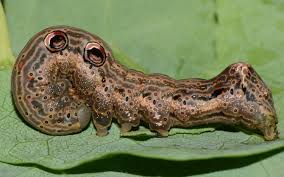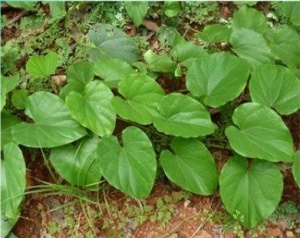Difference between revisions of "Eudocima"
(→Triclisia) |
|||
| (10 intermediate revisions by the same user not shown) | |||
| Line 26: | Line 26: | ||
[[Image:Triclisia_subcordata_2.jpg|thumb|left| Triclisia subcordata [http://www.centralafricanplants.senckenberg.de/root/index.php?page_id=34&id=1596 © Central African Plants]]] | [[Image:Triclisia_subcordata_2.jpg|thumb|left| Triclisia subcordata [http://www.centralafricanplants.senckenberg.de/root/index.php?page_id=34&id=1596 © Central African Plants]]] | ||
[[Image:Erythrina_fusca_7.jpg|thumb|right| Erythrina fusca [http://biogeodb.stri.si.edu/bocas_database/search/species/1864 © Smithsonian TRI]]] | [[Image:Erythrina_fusca_7.jpg|thumb|right| Erythrina fusca [http://biogeodb.stri.si.edu/bocas_database/search/species/1864 © Smithsonian TRI]]] | ||
| − | [[Image:Triclisia_dyctyophylla_1.jpg|thumb|left| Triclisia | + | [[Image:Triclisia_dyctyophylla_1.jpg|thumb|left| Triclisia dictyophylla [https://www.flickr.com/photos/36517976@N06/5296257706/ © Scamperdale]]] |
[[Image:Erythrina_fusca_6.jpg|thumb|right| Erythrina fusca [http://biogeodb.stri.si.edu/bocas_database/search/species/1864 © Smithsonian TRI]]] | [[Image:Erythrina_fusca_6.jpg|thumb|right| Erythrina fusca [http://biogeodb.stri.si.edu/bocas_database/search/species/1864 © Smithsonian TRI]]] | ||
[[Image:Tiliacora_leonensis_2.jpg|thumb|left| Tiliacora leonensis [http://www.liberianfaunaflora.org/FFI/Plant.aspx?p=30&ix=3545&pid=3004&prcid=0&ppid=3004&family=&species=&habit=-1&fern=0&habitat=0&geog=-1&iucn=0 © SAPO]]] | [[Image:Tiliacora_leonensis_2.jpg|thumb|left| Tiliacora leonensis [http://www.liberianfaunaflora.org/FFI/Plant.aspx?p=30&ix=3545&pid=3004&prcid=0&ppid=3004&family=&species=&habit=-1&fern=0&habitat=0&geog=-1&iucn=0 © SAPO]]] | ||
| Line 39: | Line 39: | ||
==Othreis== | ==Othreis== | ||
| − | ''Eudocima'' (aka Othreis) are very large moths (up to 10 cm wingspan) with orange abdomen. In hiding mode, they look like dead leaves. For initimidation they may reveal the bright orange markings on their hindwings. Adult Eudocima only fly, feed and mate during the night. In tropical countries, they may live up to a month. The adults feed on fruit juice by puncturing the fruit (eg [http://www.waiwiki.org/index.php?title=Mango#Mango_Moths] mango) Eggs are laid singly, or in masses (up to 750 in a cluster, which may be used for rearing [http://www.waiwiki.org/index.php?title=Mallada_sp. green lacewings]), on any part of the plant, often Erythrina species.[http://www.ncbi.nlm.nih.gov/pmc/articles/PMC3236462/] In tropical conditions, eggs hatch within 4 days. Larvae may feed around the clock and mature in 3 weeks, after which they pupate in cocoons of silk-spun leaves. Pupation favors wet conditions and occurs in 12 to 18 days.[http://www.aphis.usda.gov/plant_health/plant_pest_info/pest_detection/downloads/pra/efulloniapra.pdf] Very humid conditions favourable to development (but not heavy rains).[http://www.cabdirect.org/abstracts/19370500524.html] Pupation is always in a roomy cell made of living leaves woven together with silk and slightly lined; the pupa is attached to this lining by the cremaster.[http://www.mothsofborneo.com/part-15-16/calpini/calpini_4.php] Temperatures below 16°C during the activity period after dusk prevents feeding, mating and oviposition.[http://journals.cambridge.org/action/displayAbstract?fromPage=online&aid=2631700&fileId=S0007485300033563] Eudocima moths may be used to rear [http://www.waiwiki.org/index.php?title=Praying_mantis Praying mantids]. | + | ''Eudocima'' (aka Othreis) are very large moths (up to 10 cm wingspan) with orange abdomen. In hiding mode, they look like dead leaves. For initimidation they may reveal the bright orange markings on their hindwings. Adult Eudocima only fly, feed and mate during the night. In tropical countries, they may live up to a month. The adults feed on fruit juice by puncturing the fruit (eg [http://www.waiwiki.org/index.php?title=Mango#Mango_Moths] mango) Eggs are laid singly, or in masses (up to 750 in a cluster, which may be used for rearing [http://www.waiwiki.org/index.php?title=Mallada_sp. green lacewings]), on any part of the plant, often Erythrina species.[http://www.ncbi.nlm.nih.gov/pmc/articles/PMC3236462/] In tropical conditions, eggs hatch within 4 days. Larvae may feed around the clock and mature in 3 weeks, after which they pupate in cocoons of silk-spun leaves. Pupation favors wet conditions and occurs in 12 to 18 days.[http://www.aphis.usda.gov/plant_health/plant_pest_info/pest_detection/downloads/pra/efulloniapra.pdf] Very humid conditions favourable to development (but not heavy rains).[http://www.cabdirect.org/abstracts/19370500524.html] Pupation is always in a roomy cell made of living leaves woven together with silk and slightly lined; the pupa is attached to this lining by the cremaster.[http://www.mothsofborneo.com/part-15-16/calpini/calpini_4.php] Temperatures below 16°C during the activity period after dusk prevents feeding, mating and oviposition.[http://journals.cambridge.org/action/displayAbstract?fromPage=online&aid=2631700&fileId=S0007485300033563] Eudocima moths may be used to rear [http://www.waiwiki.org/index.php?title=Praying_mantis Praying mantids]. In Ghana Eudocima have been recorded on various crops, such as banana (E. fullonia), citrus and mango (E. fullonia, E materna, E. divitiosa).[http://ghana.ipm-info.org/list_insects.htm] [http://www.waiwiki.org/index.php?title=Mango#Mango_Moths Eudocima homaena] occurs In South America and Asia. |
. | . | ||
| Line 47: | Line 47: | ||
[http://www.thaiscience.info/journals/Article/Biological%20and%20taxonomic%20studies%20on%20immature%20and%20adult%20fruit-piercing%20moths%20in%20nepal,%20with%20reference.pdf] (Zimbabwe [http://www.cabdirect.org/abstracts/19796729206.html], Sudan [http://journals.cambridge.org/action/displayAbstract?fromPage=online&aid=765640&fileId=S1742758405000354]) to India, Vietnam, Hong Kong, Singapore, Taiwan, The Philippines, Micronesia [http://www.gbif.org/occurrence/search?taxon_key=5884188&HAS_COORDINATE=true&HAS_GEOSPATIAL_ISSUE=false], Papua New Guinea [http://www.gbif.org/occurrence/search?taxon_key=4687390&HAS_COORDINATE=true&HAS_GEOSPATIAL_ISSUE=false&offset=20], Australia [http://onlinelibrary.wiley.com/doi/10.1046/j.1440-6055.1999.00072.x/abstract], the Indian Islands and the Pacific Islands.[http://www.ncbi.nlm.nih.gov/pmc/articles/PMC3236462/] It is predominant in India.[http://www.aapmhe.in/index.php/pmhe/article/download/42/41] Eudocima fullonia was most destructive in Nigeria and Sierra Leone.[http://www.aapmhe.in/index.php/pmhe/article/download/42/41] | [http://www.thaiscience.info/journals/Article/Biological%20and%20taxonomic%20studies%20on%20immature%20and%20adult%20fruit-piercing%20moths%20in%20nepal,%20with%20reference.pdf] (Zimbabwe [http://www.cabdirect.org/abstracts/19796729206.html], Sudan [http://journals.cambridge.org/action/displayAbstract?fromPage=online&aid=765640&fileId=S1742758405000354]) to India, Vietnam, Hong Kong, Singapore, Taiwan, The Philippines, Micronesia [http://www.gbif.org/occurrence/search?taxon_key=5884188&HAS_COORDINATE=true&HAS_GEOSPATIAL_ISSUE=false], Papua New Guinea [http://www.gbif.org/occurrence/search?taxon_key=4687390&HAS_COORDINATE=true&HAS_GEOSPATIAL_ISSUE=false&offset=20], Australia [http://onlinelibrary.wiley.com/doi/10.1046/j.1440-6055.1999.00072.x/abstract], the Indian Islands and the Pacific Islands.[http://www.ncbi.nlm.nih.gov/pmc/articles/PMC3236462/] It is predominant in India.[http://www.aapmhe.in/index.php/pmhe/article/download/42/41] Eudocima fullonia was most destructive in Nigeria and Sierra Leone.[http://www.aapmhe.in/index.php/pmhe/article/download/42/41] | ||
| − | Eudocima fullonia larva feed on Erythrina variegata (Coral tree) and Stephania japonica [http://www.nhm.ac.uk/resources/research-curation/projects/chalcidoids/pdf_x/sandsli2005.pdf], but growth is better and mortality much lower when feeding on Sarcopetalum harveyanum and particularly Tinospora smilacina (Menispermaceae - the moonseed family), in comparison to Stephania japonica. Tiliacora are also readily accepted by Eudocima fullonia larva.[http://onlinelibrary.wiley.com/doi/10.1111/j.1570-7458.1994.tb01803.x/abstract] In Sierra Leone, they mainly feed on Triclisia.[http://www.cabdirect.org/abstracts/19370500524.html] In the Pacific, Eudocima fullonia larva feed on leaves of Erythrina, but elsewhere on vines in the Menispermaceae [http://www.cabdirect.org/abstracts/20066600377.html], including Tinospora homosepala [http://www.wptrc.org/userfiles/file/Physiol%20Entomol-2005.pdf], Tinospora sinensis [http://www.ccs-hk.org/DM/butterfly/Noctuid/Eudocima-phalonia.html], Tinospora cordifolia (in India, Myanmar and Sri Lanka) [http://www.plantwise.org/KnowledgeBank/Datasheet.aspx?dsid=23012], Tinospora baenzigeri, Tinospora crispa, Tiliacora triandra (in Thailand).[http://www.thaiscience.info/journals/Article/Biological%20and%20taxonomic%20studies%20on%20immature%20and%20adult%20fruit-piercing%20moths%20in%20nepal,%20with%20reference.pdf] Cocculus hirsutus [http://www.actahort.org/members/showpdf?booknrarnr=890_81], Carronia multisepala, Hypserpa decumbens (in Australia) [http://onlinelibrary.wiley.com/doi/10.1111/j.1570-7458.1994.tb01803.x/abstract], Legnephora moorei (Australia) [http://onlinelibrary.wiley.com/doi/10.1111/j.1442-9993.1993.tb00471.x/abstract], and in India on Anamirta cocculus, Convolvulus arvensis, | + | Eudocima fullonia larva feed on Erythrina variegata (Coral tree) and Stephania japonica [http://www.nhm.ac.uk/resources/research-curation/projects/chalcidoids/pdf_x/sandsli2005.pdf], but growth is better and mortality much lower when feeding on Sarcopetalum harveyanum and particularly Tinospora smilacina (Menispermaceae - the moonseed family), in comparison to Stephania japonica. Tiliacora are also readily accepted by Eudocima fullonia larva.[http://onlinelibrary.wiley.com/doi/10.1111/j.1570-7458.1994.tb01803.x/abstract] In Sierra Leone, they mainly feed on Triclisia.[http://www.cabdirect.org/abstracts/19370500524.html] In the Pacific, Eudocima fullonia larva feed on leaves of Erythrina, but elsewhere on vines in the Menispermaceae [http://www.cabdirect.org/abstracts/20066600377.html], including Tinospora homosepala [http://www.wptrc.org/userfiles/file/Physiol%20Entomol-2005.pdf], Tinospora sinensis [http://www.ccs-hk.org/DM/butterfly/Noctuid/Eudocima-phalonia.html], Tinospora cordifolia (in India, Myanmar and Sri Lanka) [http://www.plantwise.org/KnowledgeBank/Datasheet.aspx?dsid=23012], Tinospora baenzigeri, Tinospora crispa, Tiliacora triandra (in Thailand).[http://www.thaiscience.info/journals/Article/Biological%20and%20taxonomic%20studies%20on%20immature%20and%20adult%20fruit-piercing%20moths%20in%20nepal,%20with%20reference.pdf] Cocculus hirsutus [http://www.actahort.org/members/showpdf?booknrarnr=890_81], Carronia multisepala, Hypserpa decumbens (in Australia) [http://onlinelibrary.wiley.com/doi/10.1111/j.1570-7458.1994.tb01803.x/abstract], Legnephora moorei (Australia) [http://onlinelibrary.wiley.com/doi/10.1111/j.1442-9993.1993.tb00471.x/abstract], and in India on Anamirta cocculus, Convolvulus arvensis, Triclisia pattens, Pericampylus glaucus, Tiliacora acuminate and Diploclisia glaucescens.[http://www.aapmhe.in/index.php/pmhe/article/download/42/41] |
. | . | ||
==Eudocima materna== | ==Eudocima materna== | ||
| − | ''Eudocima materna'' (aka Elygea materna) feeds exclusively on the genus [http://www.waiwiki.org/index.php?title=Eudocima_phalonia#Tinospora Tinospora].[http://onlinelibrary.wiley.com/doi/10.1111/j.1442-9993.1993.tb00471.x/abstract] (widespread in tropical regions [http://link.springer.com/article/10.1007/s00606-004-0293-1#page-1], including Africa [http://informahealthcare.com/doi/abs/10.1080/14756360802333075]). Eudocima materna larva do not survive on similar species such as Caesalpinia, Cocculus or Erythrina, [http://journals.cambridge.org/action/displayAbstract?fromPage=online&aid=2319992&fileId=S0007485300003205], though they did feed on ''Rhigiocarya racemifera'' in Sierra Leone.[http://www.aapmhe.in/index.php/pmhe/article/download/42/41] | + | ''Eudocima materna'' (aka Elygea materna) feeds exclusively on the genus [http://www.waiwiki.org/index.php?title=Eudocima_phalonia#Tinospora Tinospora].[http://onlinelibrary.wiley.com/doi/10.1111/j.1442-9993.1993.tb00471.x/abstract] (widespread in tropical regions [http://link.springer.com/article/10.1007/s00606-004-0293-1#page-1], including Africa [http://informahealthcare.com/doi/abs/10.1080/14756360802333075]). Eudocima materna larva do not survive on similar species such as Caesalpinia, Cocculus or Erythrina, [http://journals.cambridge.org/action/displayAbstract?fromPage=online&aid=2319992&fileId=S0007485300003205], though they did feed on ''Rhigiocarya racemifera'' in Sierra Leone.[http://www.aapmhe.in/index.php/pmhe/article/download/42/41] and on Dioscoreophyllum tenerum in Ghana. Eudocima materna moths (8.5 cm wingspan) pierce citrus fruits, carambola and mangoes with |
| + | their barbed proboscis to feed on the juices.[http://islandbiodiversity.com/Phelsuma%2011-18.pdf] | ||
Eudocima materna occurs in Ghana (spotted at Vane and Sokode-Etoe, close to Ho in Volta region), Ethiopia, Brazil, Ecuador [http://www.gbif.org/occurrence/search?taxon_key=4687389&HAS_COORDINATE=true&HAS_GEOSPATIAL_ISSUE=false&offset=140] Sudan [http://journals.cambridge.org/action/displayAbstract?fromPage=online&aid=765640&fileId=S1742758405000354], Nigeria, Pakistan, India, Australia, Costa Rica [http://www.gbif.org/occurrence/search?taxon_key=4687389&HAS_COORDINATE=true&HAS_GEOSPATIAL_ISSUE=false&offset=40][http://www.gbif.org/occurrence/search?taxon_key=4687389&HAS_COORDINATE=true&HAS_GEOSPATIAL_ISSUE=false&offset=20][http://www.gbif.org/occurrence/search?taxon_key=4687389&HAS_COORDINATE=true&HAS_GEOSPATIAL_ISSUE=false&offset=00] and Mexico [http://www.gbif.org/occurrence/search?taxon_key=4687389&HAS_COORDINATE=true&HAS_GEOSPATIAL_ISSUE=false&offset=120], and is dominant in Zimbabwe.[http://www.cabdirect.org/abstracts/19796729206.html] Eudocima materna and fullonia moths attack citrus and mango [http://www.cabdirect.org/abstracts/19370500524.html], but particularly tomato.[http://www.aapmhe.in/index.php/pmhe/article/view/42] | Eudocima materna occurs in Ghana (spotted at Vane and Sokode-Etoe, close to Ho in Volta region), Ethiopia, Brazil, Ecuador [http://www.gbif.org/occurrence/search?taxon_key=4687389&HAS_COORDINATE=true&HAS_GEOSPATIAL_ISSUE=false&offset=140] Sudan [http://journals.cambridge.org/action/displayAbstract?fromPage=online&aid=765640&fileId=S1742758405000354], Nigeria, Pakistan, India, Australia, Costa Rica [http://www.gbif.org/occurrence/search?taxon_key=4687389&HAS_COORDINATE=true&HAS_GEOSPATIAL_ISSUE=false&offset=40][http://www.gbif.org/occurrence/search?taxon_key=4687389&HAS_COORDINATE=true&HAS_GEOSPATIAL_ISSUE=false&offset=20][http://www.gbif.org/occurrence/search?taxon_key=4687389&HAS_COORDINATE=true&HAS_GEOSPATIAL_ISSUE=false&offset=00] and Mexico [http://www.gbif.org/occurrence/search?taxon_key=4687389&HAS_COORDINATE=true&HAS_GEOSPATIAL_ISSUE=false&offset=120], and is dominant in Zimbabwe.[http://www.cabdirect.org/abstracts/19796729206.html] Eudocima materna and fullonia moths attack citrus and mango [http://www.cabdirect.org/abstracts/19370500524.html], but particularly tomato.[http://www.aapmhe.in/index.php/pmhe/article/view/42] | ||
| Line 63: | Line 64: | ||
==Tinospora== | ==Tinospora== | ||
| − | Eudocima fullonia larva may feed on leaves of various Tinospora species. Eudocima materna may feed almost exclusively on the genus Tinospora.[http://onlinelibrary.wiley.com/doi/10.1111/j.1442-9993.1993.tb00471.x/abstract] | + | Eudocima fullonia larva may feed on leaves of various Tinospora species. Eudocima materna may feed almost exclusively on the genus Tinospora.[http://onlinelibrary.wiley.com/doi/10.1111/j.1442-9993.1993.tb00471.x/abstract] Eudocima divitiosa may also feed on Tinospora.[http://www.africanmoths.com/pages/EREBIDAE/CALPINAE/eudocima%20divitiosa.htm] |
| + | * ''Tinospora bakis'' is present in Cameroon, Senegal, Somalia [http://www.gbif.org/occurrence/search?taxon_key=3830860&HAS_COORDINATE=true&HAS_GEOSPATIAL_ISSUE=false], Togo [http://www.gbif.org/occurrence/336031970], Burkina Faso [http://www.gbif.org/occurrence/1037458798] and Mali.[http://www.gbif.org/occurrence/439315078][http://www.gbif.org/occurrence/439315077][http://www.gbif.org/occurrence/438648006][http://www.gbif.org/occurrence/438315468][http://www.gbif.org/occurrence/438648008] | ||
| + | * ''Tinospora caffra'' is found in Botswana, Burundi, Malawi, Mozambique, South Africa, Tanzania, Uganda, Zambia and Zimbabwe.[http://www.gbif.org/occurrence/search?taxon_key=3830820&HAS_COORDINATE=true&HAS_GEOSPATIAL_ISSUE=false][http://www.gbif.org/occurrence/search?taxon_key=3830820&HAS_COORDINATE=true&HAS_GEOSPATIAL_ISSUE=false&offset=20] | ||
* Besides India, ''Tinospora cordifolia'' may be found in tropical Africa and Australia.[http://onlinelibrary.wiley.com/doi/10.1002/ptr.2347/abstract] | * Besides India, ''Tinospora cordifolia'' may be found in tropical Africa and Australia.[http://onlinelibrary.wiley.com/doi/10.1002/ptr.2347/abstract] | ||
| − | |||
* ''Tinospora fragosa'' is present in Namibia [http://www.gbif.org/occurrence/search?taxon_key=3830664&HAS_COORDINATE=true&HAS_GEOSPATIAL_ISSUE=false&offset=0] and South Africa.[http://www.sciencedirect.com/science/article/pii/S0254629910001158] | * ''Tinospora fragosa'' is present in Namibia [http://www.gbif.org/occurrence/search?taxon_key=3830664&HAS_COORDINATE=true&HAS_GEOSPATIAL_ISSUE=false&offset=0] and South Africa.[http://www.sciencedirect.com/science/article/pii/S0254629910001158] | ||
| − | * ''Tinospora | + | * ''Tinospora minutiflora'' [http://www.gbif.org/occurrence/1020375783] and ''Tinospora glauca'' occur in Ivory Coast.[http://www.gbif.org/occurrence/1020130025] |
| − | + | * ''Tinospora oblongifolia'' occurs in Kenya and Tanzania.[http://www.gbif.org/occurrence/search?taxon_key=3830423&HAS_COORDINATE=true&HAS_GEOSPATIAL_ISSUE=false] | |
| − | * ''Tinospora | ||
* ''Tinospora penninervifolia'' occurs in Gabon. [http://www.gbif.org/occurrence/search?taxon_key=3830388&HAS_COORDINATE=true&HAS_GEOSPATIAL_ISSUE=false] | * ''Tinospora penninervifolia'' occurs in Gabon. [http://www.gbif.org/occurrence/search?taxon_key=3830388&HAS_COORDINATE=true&HAS_GEOSPATIAL_ISSUE=false] | ||
| − | |||
| − | |||
* ''Tinospora reticulata'' occurs in Cameroon.[http://www.gbif.org/occurrence/614352524] | * ''Tinospora reticulata'' occurs in Cameroon.[http://www.gbif.org/occurrence/614352524] | ||
| + | * ''Tinospora smilacina'' (aka Snake vine, Tinospora walcottii, Tinospora berneyi) is a tropical herbaceous vine endemic to Australia [http://keys.trin.org.au/key-server/data/0e0f0504-0103-430d-8004-060d07080d04/media/Html/taxon/Tinospora_smilacina.htm], found along the boundaries of dry rainforest and dry eucalyptus forest.[http://www.somemagneticislandplants.com.au/index.php/plants/600-tinospora-smilacina] | ||
| + | * ''Tinospora tenera'' occurs in Botswana, Mozambique, Swaziland [http://www.gbif.org/occurrence/search?taxon_key=3830207&HAS_COORDINATE=true&HAS_GEOSPATIAL_ISSUE=false] and South Africa. [http://www.sciencedirect.com/science/article/pii/S0254629907003262][https://ujdigispace.uj.ac.za/bitstream/handle/10210/233/Chapte2.pdf?sequence=1&isAllowed=y] | ||
. | . | ||
==Rhigiocarya racemifera== | ==Rhigiocarya racemifera== | ||
| − | + | ''Rhigiocarya racemifera'' may be hosts for Eudocima divitiosa and Eudocima materna larva in Sierra Leone [http://www.aapmhe.in/index.php/pmhe/article/download/42/41] and for Eudocima materna larva in Ghana.[http://islandbiodiversity.com/Phelsuma%2011-18.pdf]. ''Rhigiocarya racemifera'' is related to Tinospora [http://database.prota.org/PROTAhtml/Rhigiocarya%20racemifera_En.htm], and occurs in Benin, Guinea, Ivory Coast, Liberia [http://www.gbif.org/occurrence/search?taxon_key=3830454&HAS_COORDINATE=true&HAS_GEOSPATIAL_ISSUE=false], Cameroon [http://www.gbif.org/occurrence/search?taxon_key=3830454&HAS_COORDINATE=true&HAS_GEOSPATIAL_ISSUE=false&offset=20], Nigeria [http://www.gbif.org/occurrence/298931137] and Ghana.[http://www.gbif.org/occurrence/197203344][http://www.gbif.org/occurrence/322079947][http://www.gbif.org/occurrence/621086268](at Kubease)[http://www.gbif.org/occurrence/298930707](at Akyem Adukrom)[http://www.gbif.org/occurrence/322079823] | |
| − | ''Rhigiocarya racemifera'' is related to Tinospora [http://database.prota.org/PROTAhtml/Rhigiocarya%20racemifera_En.htm], and occurs in Benin, Guinea, Ivory Coast, Liberia [http://www.gbif.org/occurrence/search?taxon_key=3830454&HAS_COORDINATE=true&HAS_GEOSPATIAL_ISSUE=false], Cameroon [http://www.gbif.org/occurrence/search?taxon_key=3830454&HAS_COORDINATE=true&HAS_GEOSPATIAL_ISSUE=false&offset=20], Nigeria [http://www.gbif.org/occurrence/298931137] and Ghana.[http://www.gbif.org/occurrence/197203344][http://www.gbif.org/occurrence/322079947][http://www.gbif.org/occurrence/621086268](at Kubease)[http://www.gbif.org/occurrence/298930707](at Akyem Adukrom)[http://www.gbif.org/occurrence/322079823] | ||
. | . | ||
==Dioscoreophyllum tenerum== | ==Dioscoreophyllum tenerum== | ||
| − | + | ''Dioscoreophyllum tenerum'' (aka Dioscoreophyllum volkensii, aka D. cumminsii) may be hosts for Eudocima divitiosa larva in Sierra Leone [http://www.aapmhe.in/index.php/pmhe/article/download/42/41] and for Eudocima materna larva in Ghana.[http://islandbiodiversity.com/Phelsuma%2011-18.pdf] | |
''Dioscoreophyllum tenerum'' occurs in Gabon, Guinea, Ivory Coast, Liberia, Tanzania [http://www.gbif.org/occurrence/search?taxon_key=5592892&HAS_COORDINATE=true&HAS_GEOSPATIAL_ISSUE=false], Cameroon [http://www.gbif.org/occurrence/search?taxon_key=5592892&HAS_COORDINATE=true&HAS_GEOSPATIAL_ISSUE=false&offset=20], Sierra Leone [http://www.aapmhe.in/index.php/pmhe/article/download/42/41], Mozambique [http://www.gbif.org/occurrence/search?taxon_key=5592892&HAS_COORDINATE=true&HAS_GEOSPATIAL_ISSUE=false&offset=100] and Ghana (near Takoradi)[http://www.gbif.org/occurrence/621108722] (near Sagyimase)[http://www.gbif.org/occurrence/250991383] (at Suhyen, Koforidua)[http://www.gbif.org/occurrence/621085311][http://www.gbif.org/occurrence/621100453]. | ''Dioscoreophyllum tenerum'' occurs in Gabon, Guinea, Ivory Coast, Liberia, Tanzania [http://www.gbif.org/occurrence/search?taxon_key=5592892&HAS_COORDINATE=true&HAS_GEOSPATIAL_ISSUE=false], Cameroon [http://www.gbif.org/occurrence/search?taxon_key=5592892&HAS_COORDINATE=true&HAS_GEOSPATIAL_ISSUE=false&offset=20], Sierra Leone [http://www.aapmhe.in/index.php/pmhe/article/download/42/41], Mozambique [http://www.gbif.org/occurrence/search?taxon_key=5592892&HAS_COORDINATE=true&HAS_GEOSPATIAL_ISSUE=false&offset=100] and Ghana (near Takoradi)[http://www.gbif.org/occurrence/621108722] (near Sagyimase)[http://www.gbif.org/occurrence/250991383] (at Suhyen, Koforidua)[http://www.gbif.org/occurrence/621085311][http://www.gbif.org/occurrence/621100453]. | ||
| Line 90: | Line 90: | ||
==Tiliacora== | ==Tiliacora== | ||
| − | Outside the Pacific, Eudocima fullonia may feed on Tiliacora species [http://www.extento.hawaii.edu/kbase/crop/type/othreis.htm], when the rain is not heavy and the humidity is not low. when not feeding on Tiliacora, it is usually feeding on Triclisia.[http://www.cabdirect.org/abstracts/19370500524.html;jsessionid=81D3E6A242674CE567EDB563B2CC6094] | + | Outside the Pacific, Eudocima fullonia may feed on Tiliacora species [http://www.extento.hawaii.edu/kbase/crop/type/othreis.htm], when the rain is not heavy and the humidity is not low. when not feeding on Tiliacora, it is usually feeding on Triclisia.[http://www.cabdirect.org/abstracts/19370500524.html;jsessionid=81D3E6A242674CE567EDB563B2CC6094] Eudocima materna may also feed on Tiliacora.[http://www.cabdirect.org/abstracts/19350500747.html] but not survive.[http://www.jbiopest.com/users/lw8/efiles/ramkumar_v32.pdf] In Ghana Eudocima materna may feed on Tiliacora species.[http://islandbiodiversity.com/Phelsuma%2011-18.pdf] |
| − | In Ghana | + | * ''Tiliacora dielsiana'' occurs in Ivory Coast [http://www.gbif.org/occurrence/search?taxon_key=3829545&HAS_COORDINATE=true&HAS_GEOSPATIAL_ISSUE=false], Liberia [http://www.gbif.org/occurrence/search?taxon_key=3829545&HAS_COORDINATE=true&HAS_GEOSPATIAL_ISSUE=false&offset=20], Sierra Leone [http://www.gbif.org/occurrence/search?taxon_key=3829545&HAS_COORDINATE=true&HAS_GEOSPATIAL_ISSUE=false&offset=60], and in Ghana, at Abura Dunkwa [http://www.gbif.org/occurrence/621095115], and near Bibiani [http://www.gbif.org/occurrence/621123710] |
| − | * ''Tiliacora | + | * ''Tiliacora dinklagei'' occurs in Ivory Coast, Gabon [http://www.gbif.org/occurrence/search?taxon_key=3829532&HAS_COORDINATE=true&HAS_GEOSPATIAL_ISSUE=false], Liberia [http://www.gbif.org/occurrence/250610194], Guinea [http://www.gbif.org/occurrence/250610259] and in Ghana, recorded at Asuoso [http://www.gbif.org/occurrence/322609308] and at Buduburam [http://www.gbif.org/occurrence/621084519] |
| − | * ''Tiliacora | + | * ''Tiliacora funifera'' occurs in Benin, Guinea, Mozambique, Tanzania, Kenya, South Africa [http://www.gbif.org/occurrence/search?taxon_key=3829501&HAS_COORDINATE=true&HAS_GEOSPATIAL_ISSUE=false], Rwana, Gabon, Somalia [http://www.gbif.org/occurrence/search?taxon_key=3829501&HAS_COORDINATE=true&HAS_GEOSPATIAL_ISSUE=false&offset=20] Central African Republic, Equatorial Guinea, Togo, Ethiopia [http://www.gbif.org/occurrence/search?taxon_key=3829501&HAS_COORDINATE=true&HAS_GEOSPATIAL_ISSUE=false&offset=40] and in Ghana, recorded near Apeguso [http://www.gbif.org/occurrence/621109098] |
| − | * ''Tiliacora | + | * ''Tiliacora leonensis'' occurs in Liberia, Guinea, Ivory Coast [http://www.gbif.org/occurrence/search?taxon_key=3829366&HAS_COORDINATE=true&HAS_GEOSPATIAL_ISSUE=false] and in Ghana, recorded at Kamgbunli [http://www.gbif.org/occurrence/1020367064], Kubease [http://www.gbif.org/occurrence/1020269978], Asuoso [http://www.gbif.org/occurrence/250610156], near Banka [http://www.gbif.org/occurrence/621086365], Ankase Game Reserve [http://www.gbif.org/occurrence/197235868] and Krokosua Hills [http://www.gbif.org/occurrence/197235916] |
| − | * ''Tiliacora | + | * ''Tiliacora louisii'' occurs in Guinea, Liberia [http://www.gbif.org/occurrence/search?taxon_key=3829359&HAS_COORDINATE=true&HAS_GEOSPATIAL_ISSUE=false], Ivory Coast, Sierra Leone [http://www.gbif.org/occurrence/search?taxon_key=3829359&HAS_COORDINATE=true&HAS_GEOSPATIAL_ISSUE=false&offset=20], and in Ghana, near Agona [http://www.gbif.org/occurrence/250610243], near Anyinasie [http://www.gbif.org/occurrence/621088835] and at Kwamikrom [http://www.gbif.org/occurrence/621095123] |
| − | * ''Tiliacora | ||
. | . | ||
| Line 102: | Line 101: | ||
==Triclisia== | ==Triclisia== | ||
When Eudocima fullonia are not feeding on Tiliacora, they are usually feeding on Triclisia. Triclisia is a family of large-leafed semi-twining plants with dense foliage near the ground.[http://www.cabdirect.org/abstracts/19370500524.html;jsessionid=81D3E6A242674CE567EDB563B2CC6094] | When Eudocima fullonia are not feeding on Tiliacora, they are usually feeding on Triclisia. Triclisia is a family of large-leafed semi-twining plants with dense foliage near the ground.[http://www.cabdirect.org/abstracts/19370500524.html;jsessionid=81D3E6A242674CE567EDB563B2CC6094] | ||
| + | * ''Triclisia dictyophylla'' occurs in Liberia, Congo, Guinea, Gabon, Cameroon [http://www.gbif.org/occurrence/search?taxon_key=3829946&HAS_COORDINATE=true&HAS_GEOSPATIAL_ISSUE=false], Ivory Coast [http://www.gbif.org/occurrence/search?taxon_key=3829946&HAS_COORDINATE=true&HAS_GEOSPATIAL_ISSUE=false&offset=20], Central African Republic [http://www.gbif.org/occurrence/322674430] and Ghana (near Odumase)[http://www.gbif.org/occurrence/621084432] (near Kwahu Tafo)[http://www.gbif.org/occurrence/322674440] (near Kwantanang)[http://www.gbif.org/occurrence/250623471]. | ||
| + | * ''Triclisia gilletii'' occurs in Cameroon, Ivory Coast [http://www.gbif.org/occurrence/search?taxon_key=3829906&HAS_COORDINATE=true&HAS_GEOSPATIAL_ISSUE=false] and Ghana (Akyem Tafo)[http://www.gbif.org/occurrence/621095102] (Akyem Adukrom)[http://www.gbif.org/occurrence/322674448] (near Suhum)[http://www.gbif.org/occurrence/621160049] (near Odumase)[http://www.gbif.org/occurrence/621100843]. | ||
* ''Triclisia patens'' occurs in Benin, Burkina faso, Ivory Coast, Guinea, Cameroon, Liberia [http://www.gbif.org/occurrence/search?taxon_key=3829813&HAS_COORDINATE=true&HAS_GEOSPATIAL_ISSUE=false], Congo [http://www.gbif.org/occurrence/250623614], Gabon [http://www.gbif.org/occurrence/250623519], Sierra Leone [http://www.gbif.org/occurrence/250623529] and Ghana (near Samreboi)[http://www.gbif.org/occurrence/197241980] (Ankasa Game Reserve)[http://www.gbif.org/occurrence/197240868] (Krokosua Forest Reserve)[http://www.gbif.org/occurrence/197241829] (near Nkwantanang)[http://www.gbif.org/occurrence/322674469] (Bia Game Production Reserve)[http://www.gbif.org/occurrence/1020422960] | * ''Triclisia patens'' occurs in Benin, Burkina faso, Ivory Coast, Guinea, Cameroon, Liberia [http://www.gbif.org/occurrence/search?taxon_key=3829813&HAS_COORDINATE=true&HAS_GEOSPATIAL_ISSUE=false], Congo [http://www.gbif.org/occurrence/250623614], Gabon [http://www.gbif.org/occurrence/250623519], Sierra Leone [http://www.gbif.org/occurrence/250623529] and Ghana (near Samreboi)[http://www.gbif.org/occurrence/197241980] (Ankasa Game Reserve)[http://www.gbif.org/occurrence/197240868] (Krokosua Forest Reserve)[http://www.gbif.org/occurrence/197241829] (near Nkwantanang)[http://www.gbif.org/occurrence/322674469] (Bia Game Production Reserve)[http://www.gbif.org/occurrence/1020422960] | ||
| − | |||
* ''Triclisia subcordata'' occurs in Benin, Burkana faso, Gabon [http://www.gbif.org/occurrence/search?taxon_key=3829770&HAS_COORDINATE=true&HAS_GEOSPATIAL_ISSUE=false], Ivory Coast [http://www.gbif.org/occurrence/search?taxon_key=3829770&HAS_COORDINATE=true&HAS_GEOSPATIAL_ISSUE=false&offset=40], Togo, Angola [http://www.gbif.org/occurrence/search?taxon_key=3829770&HAS_COORDINATE=true&HAS_GEOSPATIAL_ISSUE=false&offset=60], Nigeria [http://www.gbif.org/occurrence/search?taxon_key=3829770&HAS_COORDINATE=true&HAS_GEOSPATIAL_ISSUE=false&offset=80], Ghana (Legon, Accra)[http://www.gbif.org/occurrence/322674441] | * ''Triclisia subcordata'' occurs in Benin, Burkana faso, Gabon [http://www.gbif.org/occurrence/search?taxon_key=3829770&HAS_COORDINATE=true&HAS_GEOSPATIAL_ISSUE=false], Ivory Coast [http://www.gbif.org/occurrence/search?taxon_key=3829770&HAS_COORDINATE=true&HAS_GEOSPATIAL_ISSUE=false&offset=40], Togo, Angola [http://www.gbif.org/occurrence/search?taxon_key=3829770&HAS_COORDINATE=true&HAS_GEOSPATIAL_ISSUE=false&offset=60], Nigeria [http://www.gbif.org/occurrence/search?taxon_key=3829770&HAS_COORDINATE=true&HAS_GEOSPATIAL_ISSUE=false&offset=80], Ghana (Legon, Accra)[http://www.gbif.org/occurrence/322674441] | ||
(New Longoro - Bui National Park)[http://www.gbif.org/occurrence/1020083904] | (New Longoro - Bui National Park)[http://www.gbif.org/occurrence/1020083904] | ||
| − | |||
. | . | ||
Latest revision as of 22:25, 21 December 2014
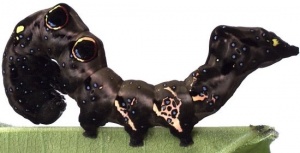
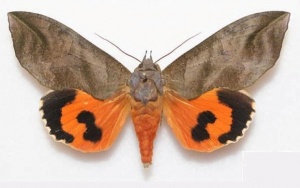
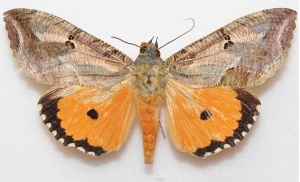

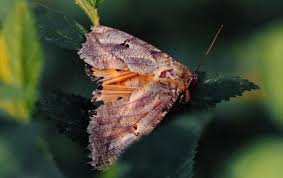
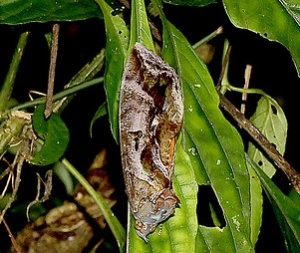
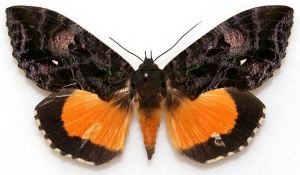
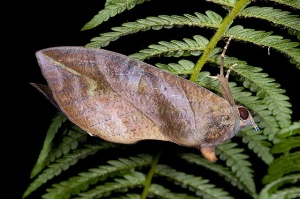
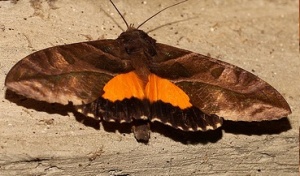
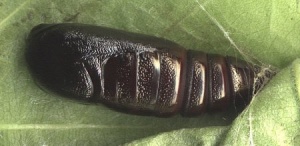

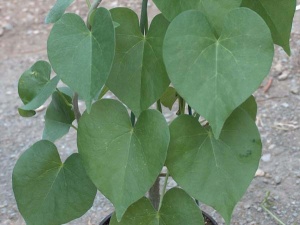
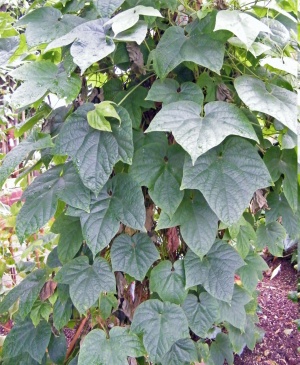
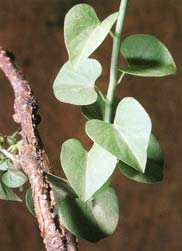
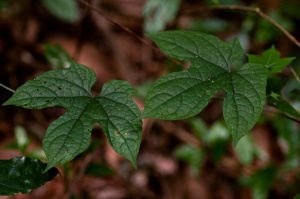
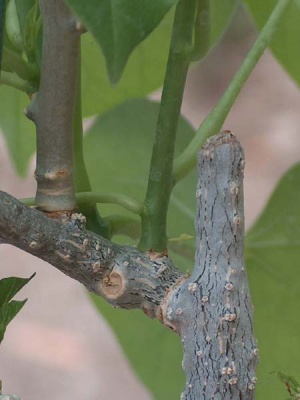

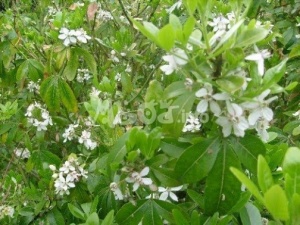

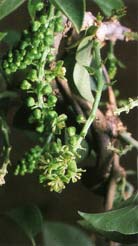
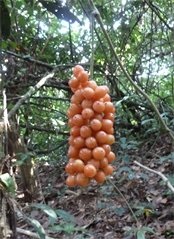
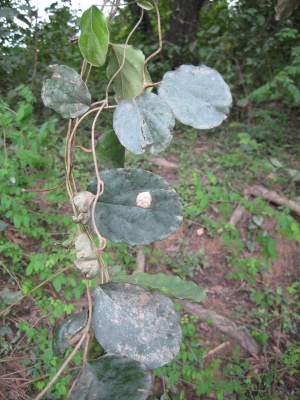
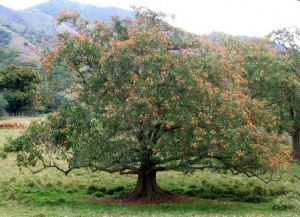

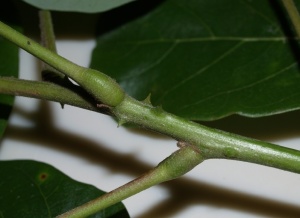

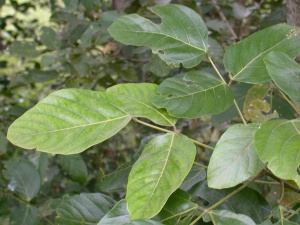
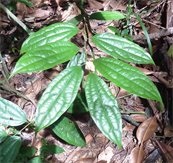
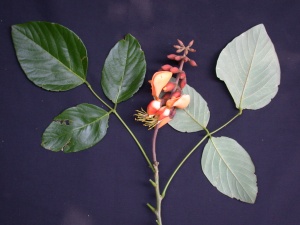
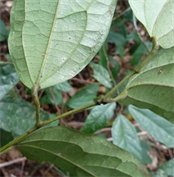
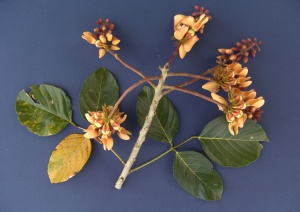
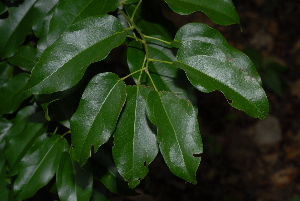
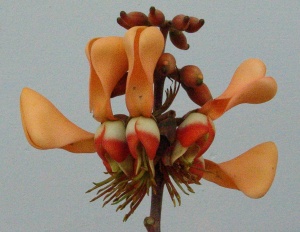
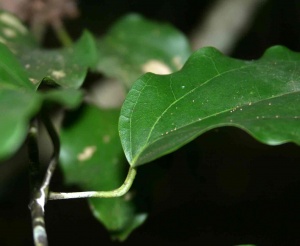
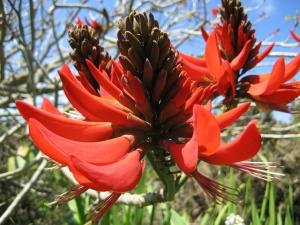
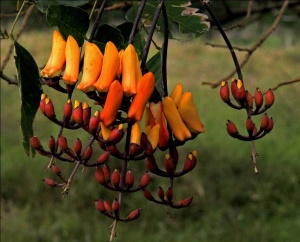
Contents
Othreis
Eudocima (aka Othreis) are very large moths (up to 10 cm wingspan) with orange abdomen. In hiding mode, they look like dead leaves. For initimidation they may reveal the bright orange markings on their hindwings. Adult Eudocima only fly, feed and mate during the night. In tropical countries, they may live up to a month. The adults feed on fruit juice by puncturing the fruit (eg [3] mango) Eggs are laid singly, or in masses (up to 750 in a cluster, which may be used for rearing green lacewings), on any part of the plant, often Erythrina species.[4] In tropical conditions, eggs hatch within 4 days. Larvae may feed around the clock and mature in 3 weeks, after which they pupate in cocoons of silk-spun leaves. Pupation favors wet conditions and occurs in 12 to 18 days.[5] Very humid conditions favourable to development (but not heavy rains).[6] Pupation is always in a roomy cell made of living leaves woven together with silk and slightly lined; the pupa is attached to this lining by the cremaster.[7] Temperatures below 16°C during the activity period after dusk prevents feeding, mating and oviposition.[8] Eudocima moths may be used to rear Praying mantids. In Ghana Eudocima have been recorded on various crops, such as banana (E. fullonia), citrus and mango (E. fullonia, E materna, E. divitiosa).[9] Eudocima homaena occurs In South America and Asia.
.
Eudocima fullonia
The most widespread species is the Eudocima fullonia aka Eudocima phalonia.[10]. It is one of the most damaging in many tropical lowland regions from West Africa (eg Sierra Leone [11], Benin [12], Ghana [13], Nigeria [14]) eastwards [15] (Zimbabwe [16], Sudan [17]) to India, Vietnam, Hong Kong, Singapore, Taiwan, The Philippines, Micronesia [18], Papua New Guinea [19], Australia [20], the Indian Islands and the Pacific Islands.[21] It is predominant in India.[22] Eudocima fullonia was most destructive in Nigeria and Sierra Leone.[23]
Eudocima fullonia larva feed on Erythrina variegata (Coral tree) and Stephania japonica [24], but growth is better and mortality much lower when feeding on Sarcopetalum harveyanum and particularly Tinospora smilacina (Menispermaceae - the moonseed family), in comparison to Stephania japonica. Tiliacora are also readily accepted by Eudocima fullonia larva.[25] In Sierra Leone, they mainly feed on Triclisia.[26] In the Pacific, Eudocima fullonia larva feed on leaves of Erythrina, but elsewhere on vines in the Menispermaceae [27], including Tinospora homosepala [28], Tinospora sinensis [29], Tinospora cordifolia (in India, Myanmar and Sri Lanka) [30], Tinospora baenzigeri, Tinospora crispa, Tiliacora triandra (in Thailand).[31] Cocculus hirsutus [32], Carronia multisepala, Hypserpa decumbens (in Australia) [33], Legnephora moorei (Australia) [34], and in India on Anamirta cocculus, Convolvulus arvensis, Triclisia pattens, Pericampylus glaucus, Tiliacora acuminate and Diploclisia glaucescens.[35]
.
Eudocima materna
Eudocima materna (aka Elygea materna) feeds exclusively on the genus Tinospora.[36] (widespread in tropical regions [37], including Africa [38]). Eudocima materna larva do not survive on similar species such as Caesalpinia, Cocculus or Erythrina, [39], though they did feed on Rhigiocarya racemifera in Sierra Leone.[40] and on Dioscoreophyllum tenerum in Ghana. Eudocima materna moths (8.5 cm wingspan) pierce citrus fruits, carambola and mangoes with their barbed proboscis to feed on the juices.[41] Eudocima materna occurs in Ghana (spotted at Vane and Sokode-Etoe, close to Ho in Volta region), Ethiopia, Brazil, Ecuador [42] Sudan [43], Nigeria, Pakistan, India, Australia, Costa Rica [44][45][46] and Mexico [47], and is dominant in Zimbabwe.[48] Eudocima materna and fullonia moths attack citrus and mango [49], but particularly tomato.[50]
.
Eudocima divitiosa
Eudocima divitiosa (aka Othreis divitiosa, aka Ophideres divitiosa) has been observed in Ghana (1 km north of Abbrafo Kakum National Park, Canopy Walkway) [51], Sierra Leone [52][53], Nigeria [54], Zimbabwe [55], Sudan [56], Cameroon, DRCongo, Equatorial Guinea, Gabon, Kenya, Malawi, Mozambique, Niger, Rwanda, South Africa, Tanzania, Uganda, Zambia [57] Eudocima divitiosa may feed on Tinospora, Dioscoreophyllum, Kolobopetalum, Penianthus, Rhigiocarya, Sphenocentrum.[58] The larval stage of Eudocima divitiosa may last 14-16 days when reared on Rhigiocarya racemifera.[59]
.
Tinospora
Eudocima fullonia larva may feed on leaves of various Tinospora species. Eudocima materna may feed almost exclusively on the genus Tinospora.[60] Eudocima divitiosa may also feed on Tinospora.[61]
- Tinospora bakis is present in Cameroon, Senegal, Somalia [62], Togo [63], Burkina Faso [64] and Mali.[65][66][67][68][69]
- Tinospora caffra is found in Botswana, Burundi, Malawi, Mozambique, South Africa, Tanzania, Uganda, Zambia and Zimbabwe.[70][71]
- Besides India, Tinospora cordifolia may be found in tropical Africa and Australia.[72]
- Tinospora fragosa is present in Namibia [73] and South Africa.[74]
- Tinospora minutiflora [75] and Tinospora glauca occur in Ivory Coast.[76]
- Tinospora oblongifolia occurs in Kenya and Tanzania.[77]
- Tinospora penninervifolia occurs in Gabon. [78]
- Tinospora reticulata occurs in Cameroon.[79]
- Tinospora smilacina (aka Snake vine, Tinospora walcottii, Tinospora berneyi) is a tropical herbaceous vine endemic to Australia [80], found along the boundaries of dry rainforest and dry eucalyptus forest.[81]
- Tinospora tenera occurs in Botswana, Mozambique, Swaziland [82] and South Africa. [83][84]
.
Rhigiocarya racemifera
Rhigiocarya racemifera may be hosts for Eudocima divitiosa and Eudocima materna larva in Sierra Leone [85] and for Eudocima materna larva in Ghana.[86]. Rhigiocarya racemifera is related to Tinospora [87], and occurs in Benin, Guinea, Ivory Coast, Liberia [88], Cameroon [89], Nigeria [90] and Ghana.[91][92][93](at Kubease)[94](at Akyem Adukrom)[95]
.
Dioscoreophyllum tenerum
Dioscoreophyllum tenerum (aka Dioscoreophyllum volkensii, aka D. cumminsii) may be hosts for Eudocima divitiosa larva in Sierra Leone [96] and for Eudocima materna larva in Ghana.[97] Dioscoreophyllum tenerum occurs in Gabon, Guinea, Ivory Coast, Liberia, Tanzania [98], Cameroon [99], Sierra Leone [100], Mozambique [101] and Ghana (near Takoradi)[102] (near Sagyimase)[103] (at Suhyen, Koforidua)[104][105].
.
Tiliacora
Outside the Pacific, Eudocima fullonia may feed on Tiliacora species [106], when the rain is not heavy and the humidity is not low. when not feeding on Tiliacora, it is usually feeding on Triclisia.[107] Eudocima materna may also feed on Tiliacora.[108] but not survive.[109] In Ghana Eudocima materna may feed on Tiliacora species.[110]
- Tiliacora dielsiana occurs in Ivory Coast [111], Liberia [112], Sierra Leone [113], and in Ghana, at Abura Dunkwa [114], and near Bibiani [115]
- Tiliacora dinklagei occurs in Ivory Coast, Gabon [116], Liberia [117], Guinea [118] and in Ghana, recorded at Asuoso [119] and at Buduburam [120]
- Tiliacora funifera occurs in Benin, Guinea, Mozambique, Tanzania, Kenya, South Africa [121], Rwana, Gabon, Somalia [122] Central African Republic, Equatorial Guinea, Togo, Ethiopia [123] and in Ghana, recorded near Apeguso [124]
- Tiliacora leonensis occurs in Liberia, Guinea, Ivory Coast [125] and in Ghana, recorded at Kamgbunli [126], Kubease [127], Asuoso [128], near Banka [129], Ankase Game Reserve [130] and Krokosua Hills [131]
- Tiliacora louisii occurs in Guinea, Liberia [132], Ivory Coast, Sierra Leone [133], and in Ghana, near Agona [134], near Anyinasie [135] and at Kwamikrom [136]
.
Triclisia
When Eudocima fullonia are not feeding on Tiliacora, they are usually feeding on Triclisia. Triclisia is a family of large-leafed semi-twining plants with dense foliage near the ground.[137]
- Triclisia dictyophylla occurs in Liberia, Congo, Guinea, Gabon, Cameroon [138], Ivory Coast [139], Central African Republic [140] and Ghana (near Odumase)[141] (near Kwahu Tafo)[142] (near Kwantanang)[143].
- Triclisia gilletii occurs in Cameroon, Ivory Coast [144] and Ghana (Akyem Tafo)[145] (Akyem Adukrom)[146] (near Suhum)[147] (near Odumase)[148].
- Triclisia patens occurs in Benin, Burkina faso, Ivory Coast, Guinea, Cameroon, Liberia [149], Congo [150], Gabon [151], Sierra Leone [152] and Ghana (near Samreboi)[153] (Ankasa Game Reserve)[154] (Krokosua Forest Reserve)[155] (near Nkwantanang)[156] (Bia Game Production Reserve)[157]
- Triclisia subcordata occurs in Benin, Burkana faso, Gabon [158], Ivory Coast [159], Togo, Angola [160], Nigeria [161], Ghana (Legon, Accra)[162]
(New Longoro - Bui National Park)[163]
.
Erythrina
Erythrina (Coral tree) is traditionally reproduced from large cuttings although seeds are usually viable. Due to the high level of outcrossing, there should be considerable variability in trees produced from seed. The trees are usually established by planting two or three seeds directly in each pit or by planting seedlings raised in a nursery. Erythrina spp. are universally recognised for their high biomass productivity and utilisation almost always involves frequent pruning. [164]
- Erythrina abyssinica (aka Erythrina tomentosa) occurs in Cameroon, Ethiopia, Mozambique, Tanzania, Zambia, Zimbabwe [165], Uganda, Kenya [166], Botswana, Burundi [167], Angola [168] DR Congo [169]. Erythrina abyssinica grows optimally at 15-25°C with 500 to 2000 mm rainfall. It grows in woodland, wooded grassland and in secondary scrub vegetation, and closely resembles Erythrina latissima. Its wood is used for many purposes (incl. drums, carvings, mortars, stools, beehives). Its flowers provide nectar and pollen. The leaves are eaten by sheep and goats. Trees are fire resistant and even its seedlings resprout after fire. [170]
- Erythrina addisoniae grows up to 20 meters tall and is very similar to Erythrina thaloniana (up to 12 m tall).[171] Erythrina addisoniae occurs in Cameroon, Ghana, Nigeria and Sierra Leone. [172]
- Erythrina burana occurs in Ethiopia [173].
- Erythrina excelsa is usually found in riverine and swamp forest. The trees grow very fast (up to 30 meter tall[174]) and usually flower when they are quite leafless. Its seeds are liable to insect attacks. Its wood is often used for making drums.[175] It occurs in Benin, Cameroon, Ghana, Tanzania [176], DR Congo and Liberia [177].
- Erythrina fusca is pantropical, occurring in South America, Australia, Asia, DR Congo, Equatorial Guinea [178], Madagascar [179] and Ghana (Amansie east; close to Lake Bosumtwi) [180]. Erythrina fusca is found throughout coastal regions of the tropics where it shows considerable tolerance to flooding and saline conditions.[181]
Eudocima phalonia is known to feed on Erythrina fusca [182] The large orange flowers of Erythrina fusca are adapted for pollination by birds and are protected from illegitimate visits by a petal that covers the nectaries and anthers until displaced by a foraging bird. Dusky-headed Parakeet (Aratinga weddellii) and Cobalt-winged Parakeet (Brotogeris cyanoptera), and probably the orange-backed Troupials (Icterus jamacaii), appear to be the main pollinators. Legitimate visitors facilitate access by hummingbirds. [183] The male orchard oriole (Icterus spurius) is shown to be the most effective pollinator of Erythrina fusca.[184] Because ants are poor pollinators, Erythrina fusca renders sugar solutions significantly less palatable to ants.[185]
- Erythrina haerdii occurs in Tanzania [186].
- Erythrina humeana occurs in Swaziland [187], Egypt, Mozambique, South Africa, Zambia and is kept in the Berkeley Herbarium in California and in the Ho'omaluhia Botanical Garden in Honolulu.[188]
- Erythrina lysistemon occurs in Botswana [189], Madagascar [190], Mozambique, Zimbabwe [191], Ethiopia, South Africa, Swaziland [192], Tanzania, and in the collection of the Herbarium of The New York Botanical Garden.[193]
- Erythrina mildbraedii occurs in Ivory Coast, Ghana, Nigeria [194] Guinea, Sierra Leone, Liberia, Cameroon and Gabon [195].
- Erythrina sacleuxii occurs in Kenya, Tanzania and Mozambique, and is also present in the collection of the Missouri Botanical Garden.[196]
- Erythrina senegalensis occurs in Benin, Burkina Faso, Ghana (name: surukasuru), Guinea, Senegal [197], Cameroon [198], Côte d'Ivoire, Nigeria [199], Togo [200], Mali [201], Liberia [202], Sierra Leone, Madagascar [203], Chad, Gambia, Guinea Bissau and Niger. It grows in dry open savanna woodlands, burned savanna, plateau with fine gravel, degraded regrowths, coastal savanna (in Ghana), bank of streams and roadsides by grassland.[204] The plant is taken as a fodder and is also used for composting and manuring in cultivating fields. The mode of propagation is by seed.[205]
- Erythrina variegata occurs in Benin [206], Madagascar [207], Mozambique [208], Asia, Australia [209], South America, and is preserved in Cotongo, Benin [210] Eudocima phalonia is known to feed on Erythrina variegata. [211]
- Erythrina vogelii (aka Erythrina bancoensis) is present in Benin, Cameroon, Gabon, Guinea, Ghana, Ivory Coast [212], Burkina Faso [213] and Nigeria [214]. Erythrina vogelii is a pioneer, often in secondary forest and abandoned agricultural fields, mostly in swamps, but also savanna. In Ghana Erythrina vogelii trees are rare, and leafless for several months between July and January. In Côte d'Ivoire they flower from October to February. It contains only traces of alkaloids and it looks a lot like Erythrina senegalensis and its also small with poor wood quality.[215] They may grow up to 15 m tall.[216]
